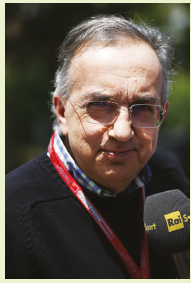Question: 1. In relation to Section 15.3, what were the types of change pursued at Fiat and Chrysler? Were these appropriate to the change contexts? 2.
1. In relation to Section 15.3, what were the types of change pursued at Fiat and Chrysler? Were these appropriate to the change contexts?
2. How would you describe the leadership style of Sergio Marchionne? Was this appropriate to the change contexts?
3. What levers for change were employed by Sergio Marchionne? What others might have been used and why?
4. By what criteria would you assess the effectiveness of the change programmes at Fiat and Chrysler?
In 2009, two of America’s three largest automotive makers, General Motors and Chrysler, were bankrupt. General Motors was rescued by the US government, with loans and a substantial equity stake. Chrysler was rescued by an Italian company with a decidedly mixed reputation, Fiat. At the head of Fiat was Sergio Marchionne, an Italian– Canadian accountant with just four years’ experience in the auto industry. Marchionne undertook radical change at Chrysler, but six years later ended up offering the company for sale to General Motors – and was rejected.
Nonetheless, Marchionne had transformed Chrysler through his energetic leadership style. He is famous for his constant smoking, his heavy consumption of espresso coffees and his informal dress sense, based on sweaters rather than traditional suits. At the same time, Marchionne is a notorious workaholic: no lower than 42 executives report directly to him, he carries six mobile phones, and he works 14–18 hour days, seven days a week. Regarding leadership, he explained to the Harvard Business Review: ‘My job as CEO is not to make decisions about the business but to set stretch objectives and help our managers work out how to reach them.’ 1
Marchionne at Fiat
When Marchionne took over as CEO at Fiat in 2004, he was the fifth CEO since 2001. The company was unprofitable, the products had a reputation for poor quality, its most recent new car launch had been unsuccessful and relationships with the unions were poor.
At Fiat, Marchionne spent his first 50 days touring the business, listening to people and analysing the situation. He found that senior executives were unused to taking responsibility for decisions; everything was referred upwards to the CEO. Executives communicated with each other via their secretaries and spent their time fire-fighting or avoiding problems. The company was dominated by engineers, who would work on new models in isolation. They then passed on their finished designs to sales and marketing, complete with sales targets and price. As well as being inefficient, this procedure caused fierce tensions between departments.
Following initial measures to reduce Fiat’s debt level, Marchionne turned his attention to the leadership of the

business. Many senior executives were dismissed and 2000 other managers and staff were retired early. On the other hand, as he toured the company, he had identified young talented managers, often in areas such as marketing that were not the traditional routes to the top, or in geographic areas such as Latin America that were less influenced by head office and where managers tended to behave more autonomously. He drew on this ‘talent spotting’ to make 20 new leadership appointments as well as other promotions.
Marchionne took a close interest in high potential talent and regarded his personal engagement with them as more valuable than more formal assessment. He also believed that such personal engagement helped develop a top team with strongly held common values. His expectation of this new top cadre of leaders was that they should be given responsibility. He recognised that this was demanding:......
ort Rai S
Step by Step Solution
3.41 Rating (157 Votes )
There are 3 Steps involved in it
Certainly at Fiat on the engineering side which was the dominant function there was a highly homogeneous lack of diversity mindset which contributed to the problems There was a low capability for chan... View full answer

Get step-by-step solutions from verified subject matter experts


